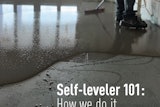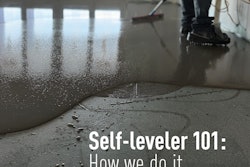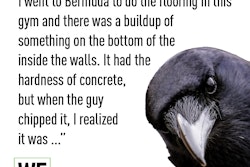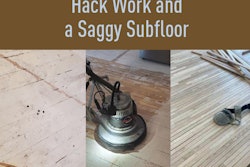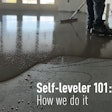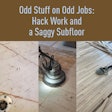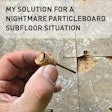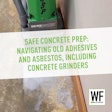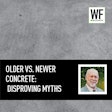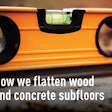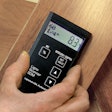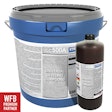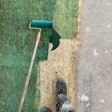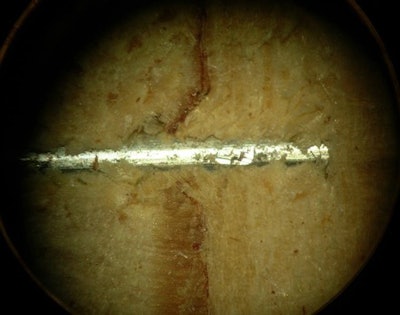
I had another call last week about loose floors over OSB. The hardwood flooring could be pulled up by hand with minimal force. OSB panels are often used instead of plywood as subflooring. I don't hear of this issue with plywood, so what's special or different about OSB?
OSB is an acronym for oriented strand board, a type of mat-formed panel with oriented layers resulting in directional properties. The panels are typically made of three mats, or layers. Each layer typically contains the same species or mix of wood, but some manufacturers use different adhesive in the top and bottom face mats than they use on the core mat. The most important difference between the layers is the density of the flakes or strands. The density of the core mat can be approximately 60% that of the face mats. From an engineering standpoint, this makes sense. Think of an I-beam or an I-joist. Much of the stiffness and strength in a beam or joist comes from the material farthest from the center. Lay an I-joist on its side and it bends like crazy. Stand it up and it is stiff. That's because there is more material farther from the center.
To make OSB stiff, more material is placed as far as possible from the center. If you use a sharp saw to cut a piece of OSB, you can actually see the different mats and densities. The core mat has more voids than do the face mats. Both density and voids affect fastener holding.
PS-2 is a voluntary Performance Standard for wood-Based Structural-Use Panels developed by the APA, and is the accepted performance standard for OSB products. Under PS-2, OSB used for subflooring must have a minimum nail withdrawal strength of 20 pounds force when kept dry or 15 pounds force when wetted and re-dried. According to testing done by Virginia Tech, the average minimum withdrawal strength they measured after moisture cycling was 62 pounds force.
So the minimum allowable per PS-2 is 20 pounds. Testing showed a minimum of about 62 pounds. Why do the floors come loose? An item worth mentioning is that PS-1, the performance standard for plywood, does not include a nail withdrawal requirement.
Fastener withdrawal depends on several conditions. Most engineering manuals use density to determine fastener withdrawal characteristics. The higher the density, the more force necessary to withdraw the fastener. Grain orientation also affects fastener withdrawal. When a fastener is driven into wood perpendicular to the grain, the fibers are forced apart and often cut. The cut ends of the fibers actually bend and point downward. When the fastener is pulled out, the fibers tend to bend back upward, and in the process squeeze the fastener even tighter. Here's a cross-section of a fastener in plywood:
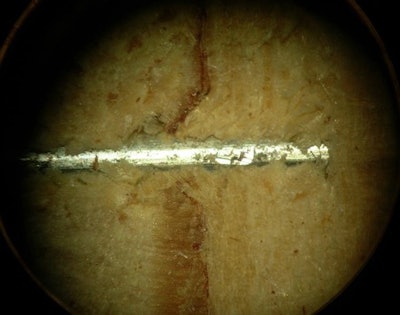
In OSB, the voids between strands and even the strand orientation interrupt bending of the fibers and the resulting squeeze. Here's the same image of a fastener in OSB:

To help increase the fastener holding, fasteners are often coated with a thermoset plastic. As the fastener is driven into the wood, the plastic melts. When the plastic cools, it forms a bond between the fastener and the wood.
The end result is that much of the fastener strength in OSB is due to the thermoplastic bond. Some strength is gained by squeezing the fibers. The thermoplastic bond is brittle, and not as flexible as the fiber bond. A very small movement of the fastener can result in breaking of the thermoplastic bond. Once the thermoplastic bond is broken, the fastener is essentially loose.
Does this mean that OSB is bad subflooring? No. I have seen many floors work fine with OSB subfloors. In many other cases, the loose flooring was removed and reinstalled on the original OSB, with no recurrence of the looseness problem. That alone tells me that it is not strictly an OSB issue.
What can be done to prevent loose fasteners in OSB? First, use standard procedures to reduce potential movement of the hardwood flooring to a minimum. Acclimate it well. Acclimate it thoroughly. Acclimate it properly. (What does "acclimation" really mean? See my post about it here.) (Removing and reinstalling floors over OSB without recurrence of looseness problems is in part because the floors are now well-acclimated.) Get the building stable and to within long-term conditions before installing the flooring. Then, pay attention to what increases movement in floors. Select a narrower, stable species of flooring.
OSB, like many other products, serves its designed purpose, and does so efficiently and economically. OSB's purpose is to provide a code-acceptable subfloor. (Code means life-safety, not performance, appearance or workmanship.) As with most all products, there may be better products out there for a particular situation. Wide plank unstable species of floors like hickory may work better on a different subfloor material.










